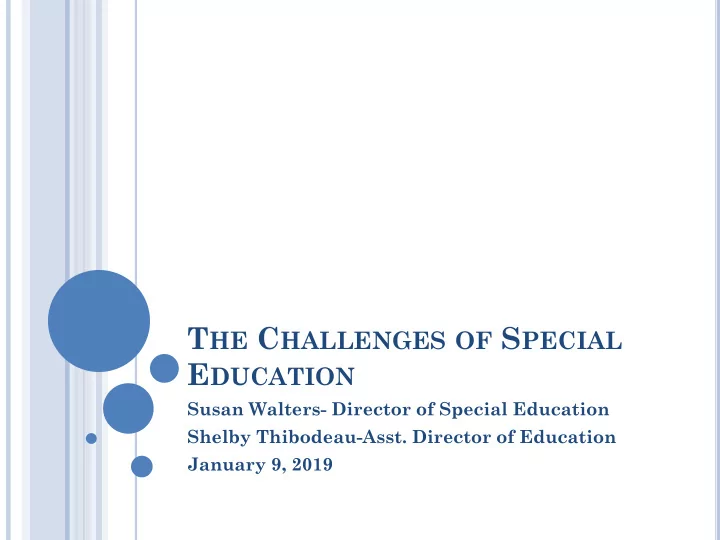

T HE C HALLENGES OF S PECIAL E DUCATION Susan Walters- Director of Special Education Shelby Thibodeau-Asst. Director of Education January 9, 2019
C URRENT S TUDENTS IN S PECIAL E DUCATION 390 Special Education students: Autism 37 students Emotional Disturbance 8 students Hearing Impairment 1 student Intellectual Disability 24 students Multiple Disabilities 49 students Other Health Impairment 99 students Specific Learning Disability 86 students Speech or language impairment 86 students Visual impairment 1 student 16 Students attending an Out of District Placement: Margaret Murphy-Lewiston/Auburn Spurwink-Chelsea Central Maine Learning Center-Belgrade Androscoggin Learning and Training Center-Auburn Goodwill Hinkley-Hinkley Incoming Kindergartners 2019 (currently identified under Child Development Services CDS): 19 Speech and language, 5 Autism, 4 Other health impairment (possible behavior)
C URRENT S PECIAL E DUCATION STAFF 31 K-12 Teachers Cony 7-12 (10): Functional Skills, Resource, Student Support Lincoln (4): Autism, Resource, And Functional Skills Gilbert (4): Resource, Student Support Farrington: Resource (5), Student Support, Functional Skills Hussey (1): Resource Speech/OT (7) 52 Educational Technicians K-12
B UDGET Local Entitlement (Federal Money) 92% supports salary and benefits of staff 8% contracted services (Psychological, Physical Therapy) Local Budget (Local money) Salary and benefits, instructional supplies, course reimbursement and professional development
C HALLENGES THAT IMPACT THE BUDGET WITHIN THE SCHOOL YEAR Cost drivers that would be unknown or unable to predict during budget development: Level of support needed to meet the student who moves to the district after the budget has been finalized. Possibly requiring: Educational Day treatment setting Educational Technician Support Special Transportation Or other specialized supports Incoming Kindergarten students 2019: Do not always know of their needs due to the status of CDS at this time or the child has not participated in an Early Childhood program previous to Kindergarten. Students moving in and out of district can significantly effect the budget.
P ROCESS OF REFERRAL Requirement of Response To Intervention (RTI) The time and documentation required for General Education classrooms. Particularly, if the concern is with a student’s behavior New state referral form Must demonstrate the level of interventions that have been implemented prior to referral.
R EGULATIONS AND MANDATES Chapter 101-Special Education Law Special education mandated to follow certain procedures and policies, creating an arduous task for all staff. Least Restrictive Environment Providing students access to the General Education setting without disrupting the learning of others Often special education staff “pushes” into classrooms, providing services through co teaching. Chapter 33-Restraint and Seclusion – Rules and Regulations
M ITIGATING F ACTORS English Language Learners Validity of testing Referral process Truancy/Chronic Absenteeism Effect on eligibility Discipline Manifestation Determination Directly and substantially related to child’s disability Tutoring services Provided when a student is placed on suspension beyond 10 days CUMULATIVELY.
S TATE T ESTING 1% of students who are in the testing grades can participate in alternate assessment Math grades 3-8 (MSAA) English/Language Arts 3-8 (MSAA) Science 5, 8, 11 (PAAP) SAT 3 rd year of high school Stringent requirements to participate in alternate assessment Must use the Determination Flow Chart WIDA testing Proficiency testing for English Language Learners Significantly impacts district’s overall testing results. More students who previously took the alternate assessment are now required to take the regular assessment.
R ETENTION OF STAFF Keeping educated, experienced and talented staff Balancing the health of employees with the significant needs of the students.
M AINTAINING B ALANCE Throughout the year, it is a constant balancing act of meeting student and staff needs based on the unpredictable challenges we encounter on a daily basis. Requiring: Problem Solving skills Adequate and necessary funding Knowledge of regulations and mandates Dedicated and healthy staff Student-centered decisions
Recommend
More recommend